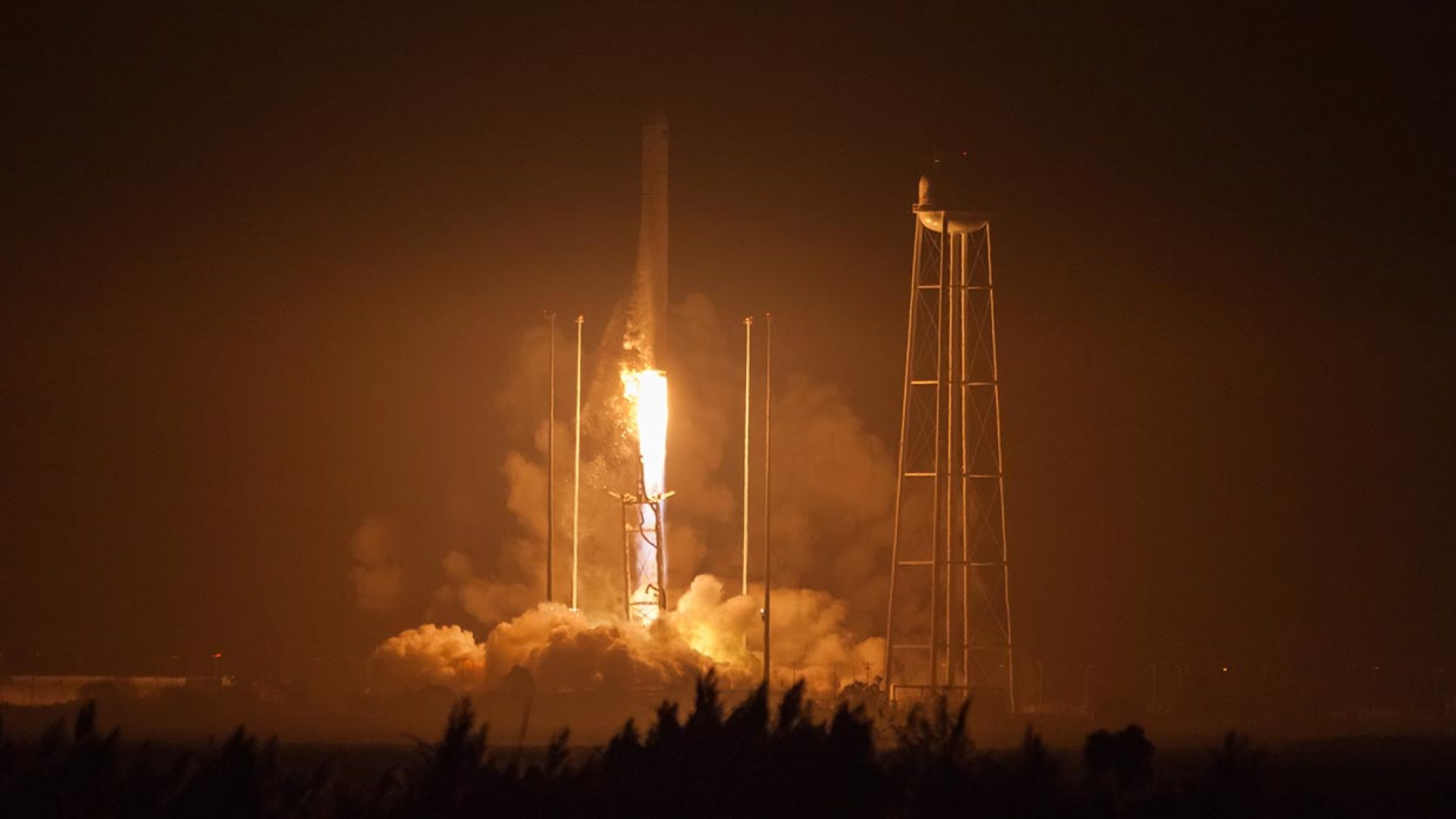Issue #1

What a week I picked to start this column. Three launches—two crewed, one cargo—to two space stations, ExoMars’ two-part arrival at Mars, Juno’s troubles at Jupiter, and some interesting details emerged regarding commercial cargo and crew. This is probably quite a bit longer than most of these will be, but this was likely the most jam-packed week of spaceflight news this entire year.
OA–5: Return to Flight of Antares
Orbital ATK’s Antares launch vehicle returned to flight in spectacular fashion with a night launch visible for hundreds of miles across the US. We’ve been anxiously awaiting the return-to-flight for Antares since its 2014 failure and subsequent changing of its engines.
I made the trek down to Virginia for the launch, and it was quite an experience. I posted a handful of photos and videos from my trip, including a beautiful timelapse of launch-to-MECO and a 4K video complete with the chest-rattling sound of Antares’ RD–181 engines. Make sure to listen to the sound the RD–181s make when they ignite. It’s pretty unique, and it was certainly felt more than it was heard. It was a pretty jarring shockwave from just over a mile away.
Antares’ return to flight is a big deal for Orbital ATK, as well as for NASA. Cygnus is now back operating regularly—OA–7 is on deck for the end of 2016, though I’d bet it pushes to 2017—which is great news for ISS logistics. Let’s hope Falcon 9 makes its return to flight soon (a lot of little birdies are indicating that the investigation is nearing completion), so that Dragon can be up and flying to the ISS, too.
On my long, partially-sleep-deprived drive home from Virginia after the OA–5 launch, I recorded this week’s episode of the podcast and talked all about the launch itself, what Antares’ future may look like (including speculation about an AR1-powered first stage), and where Orbital ATK goes from here. I’m more than a little skeptical about Antares’ prospects beyond ISS logistics, and about Orbital ATK’s sprawling plans for the future.
The question “Are they doing too much?” often gets asked of SpaceX, but it certainly feels appropriate when considering what Orbital ATK has talked about—Cygnus beyond ISS, Antares beyond Cygnus, a next-generation launch vehicle, work on greener monopropellants like LMP–103S, and plenty more. Orbital ATK certainly has a lot of history which, rightly so, protects them from a lot of questions of this sort, but I don’t think we should gloss over how much they’re talking about. The key questions:
Without contracts or outside funding, which of these projects would they tackle on their own? And will they be able to be nimble enough to bring these projects to life, especially a seemingly-expendable so-called next-generation launch vehicle?
ExoMars 2016
It’s been an up and down week over at Mars. ESA’s Trace Gas Orbiter was successfully inserted into a highly-elliptical orbit. The TGO was sent to Mars to investigate the sources of methane in the Martian atmosphere. The answers we get will be hugely beneficial to two things: the search for life, and the production of rocket propellant on the surface of Mars.
The TGO—which is the primary mission of ExoMars 2016—arrived at Mars successfully, but the Schiaparelli lander didn’t fare so well. It sounds like after separating from the backshell, the descent engines began firing, but cut off shortly thereafter. By the sound of it, Schiaparelli slammed into the surface at quite a high speed.
While Schiaparelli was an entry, descent, and landing demonstrator, its failure is a public relations nightmare and potentially politically harmful. ESA went right into full spin mode and tried very hard to brand this as a good thing—a test mission fulfilling its destiny!
Here’s the problem: ExoMars 2020 was already delayed once (2018 to 2020), and the ExoMars program as a whole has had financial issues, especially so since NASA pulled out in 2012. Any failure in the program is a threat to funding—that’s how it works with governmental missions. Let’s hope they can weather whatever storm may be caused by this failure, and go on relatively unscathed toward the 2020 mission.
The Schiaparelli failure may be more technically harmful than politically, though. Schiaparelli was an EDL demonstrator that would pave the way for the more complex and harrowing EDL for the 2020 rover. While they got plenty of data on the entry and descent part, it doesn’t seem like they got much about the landing. If they can’t figure out the cause of the engine failure, that would make me a bit nervous for 2020’s landing.
I’d suggest following along with my friend Jake Robins of the WeMartians podcast for smarter and more extensive ExoMars coverage.
Juno’s Rough Week
Out a bit farther, Juno had a rough week at Jupiter. The team postponed an orbit-lowering maneuver due to a sticky valve in the propulsion system. The maneuver would have brought it from a highly-elliptical 53-day orbit to a 14-day orbit, which would allow the main science phase of the mission to begin. Then, 13 hours before perijove, Juno went into safe mode, disabling all scientific instrumentation during its close pass with Jupiter.
Individually, these two issues aren’t major worries, and like ESA, NASA went into PR spin mode. Here’s the worrying thing: Juno is in one of the most harmful radiation environments in the solar system and was originally intended to conclude in February, 2018 with a plunge into Jupiter’s atmosphere. Any lost time is sad, but missing a close approach and losing several 14-day scientific orbits while stuck in the 53-day orbit isn’t great, regardless of how much NASA tries to spin it.
Odds and Ends and the Weeks Ahead
Some details came out about SpaceX’s plans for Dragon. They’ll be switching over all their production lines to Dragon 2, begin reusing Dragon pressure vessels on SpX–11, and all CRS–2 cargo flights will use Dragon 2 with a propulsive landing on return. That’s an exciting roadmap for Dragon 2, and the fact that NASA will allow propulsive landings on CRS flights is huge.
I was worried that NASA might be too precious about Dragon’s downmass and not want to add “unnecessary risk” to the flights. The benefits of quick access to returned cargo probably outweigh the risks—especially considering how many landings SpaceX will have done by the time CRS–2 kicks off (between Falcon 9 and Dragon 2/Red Dragon tests)—and they’ll get downmass redundancy with Dream Chaser’s inclusion.
Atlas V will be putting on a turtleneck for Starliner flights. United Launch Alliance and Boeing revealed the solution to their vibration and ascent issues for Starliner-Atlas V flights. It‘s ugly, and it still is somewhat shocking to me that this problem was discovered and fixed so late in the process.
On the “what to keep an eye on” front, it sounds like we’re getting close to hearing a bit more about SpaceX’s investigation into the Amos–6 explosion. They keep saying they’ll return to flight this year, and if it really is a process issue as Gwynne Shotwell hinted at, maybe they can get one off in December.
Also of interest: China launched Shenzhou–11—with a crew of two taikonauts—and docked with Tiangong–2 to kick off a month-long stay. With China’s increasingly open communication about their space program, it’ll be very interesting to follow along with this mission.
Thank you!
Thanks for reading this first issue of Main Engine Cut Off Weekly. It’s probably quite a bit longer than most of these will be, but this was potentially the most jam-packed week of spaceflight news this entire year. I’ll be honest in that I’m figuring this out as I go along. I’m just a single person bringing you what I find interesting and important in spaceflight, and I hope to bring it to you however you like to have it—be it a blog, podcast, or this here column.
If you like what I’m doing, I’d really, really appreciate your support. Head over to Patreon and become a patron for as little as $1 per month. Everything I do is supported entirely by readers and listeners like you, and every little bit of support helps. Big thanks to those of you out there supporting!
If you’d rather help support another way, I’d love for you to help spread the word—tell a friend about Main Engine Cut Off, tweet a link, or submit something interesting I’m writing or saying to your favorite subreddit.
Thank you so much for reading, and I’ll talk to you next week.
— Anthony
 Main Engine Cut Off
Main Engine Cut Off